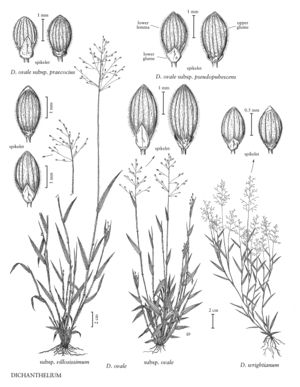Dichanthelium ovale subsp. ovale
Basal blades 3-8 cm, rigid, with long hairs on or near the bases and margins. Culms more than 1 mm thick, stiff; lower internodes pilose; upper internodes short-pilose to nearly glabrous. Cauline sheaths with ascending hairs, hairs to 4 mm, not papillose-based: ligules 1-4 mm; blades 5-12 mm wide, firm, ascending, abaxial surfaces appressed-pubescent, adaxial surfaces nearly glabrous except for the long hairs on or near the scabridulous margins and bases. Spikelets 2.5-3 mm, ellipsoid, sparsely to densely pilose. 2n = 18.
Discussion
Dichanthelium ovale subsp. ovale grows in dry, open, sandy woods, pinelands, and sandhills along the east coast of the United States from New Jersey south¬wards, extending into the coastal plain from eastern Texas to South Carolina, and in Mexico, Honduras, Guatemala, and Nicaragua. It intergrades somewhat with subsp. pseudopubescens. Occasional long-spikelet specimens exhibit morphological characteristics of D. oligosanthes and D. commutatum.
Selected References
None.
